Research - (2021) Volume 0, Issue 0
Macrozoobenthos of Alijanchay riverâthe primary indicator of biodiversity within the Greater Caucasus in the territory of Azerbaijan
S. Aliyev1, V.F. Mammadova2* and L.R. Abdullayeva2Abstract
The article provides information on the biodiversity of the Alijanchay, one of the left tributaries of the Kura River, which originates in the highlands and is formed by inland waters and its main component macrozoobenthos, its species composition, biocenosis distribution, and ecological features. It is known that macrobenthic organisms are actively involved in forming the biological productivity of water bodies, the natural biofiltration of water. At the same time, biological indicators are organisms and form a link in the food chain in the ecosystem. Certain species are the first or second interim owners of parasites. It is worth mentioning some species, which prevent the regular operation of hydro-technical facilities. The river is mainly polluted by household waste. Recently, the development of agriculture and the increase in the number of fertilizers and various drugs applied to the soil have impacted the ecological stability of the river. Thus, the decrease in the species and number composition of fish formed in the river proves it again.
The main task of the study is to assess the current state of biodiversity in the river, the general ecological status of the river, and determine the level of impact of natural and anthropogenic impacts on macrozoobenthos. The main focus here is done on macrobenthos, however, the forest and vegetation of riparian zones. During the study period, 154 species of organisms have been found, where 80 species of found organisms (52%) belong to river macrozoobenthos, 42 species (27%) to plants, and 32 species (21%) to vertebrates.
Keywords
River, macrozoobenthos, benthos, species, biocenosis, biotope.
Introduction
The complexity of the relief in the territory of the Republic of Azerbaijan provides an opportunity to carry out its vertical ranking into the high mountain terrane, intermediate-level mountain terrane, low-level mountain terrane, and plain-lowland terranes. The high mountainous belt covers the areas higher than 2500 m, the medium mountainous belt between 1000-2500 m, and the low mountainous belt encompasses 200-1000 m. There are many rivers, lakes, and forests in the Greater Caucasus and Lesser Caucasus areas. Most of the rivers are right and left tributaries of the Kura River that flows through the Kura Basin occupying the central part of the Republic of Azerbaijan. Four large reservoirs of great economic importance have been constructed over the Kura River. Certain rivers merge with water reservoirs. Within the framework of the project, the biodiversity of the Alijanchay River laid in the Greater Caucasus has been studied. The research was conducted to study river hydrobionts, riparian vegetation, and fauna. The study covered the period from November 2018 up to March 2020. The study of those areas provides great scientific and economic significance. Monitoring was carried out comparatively. The studied rivers indicated the biocenoses replacing each other. Every biocenosis has its characteristic habitat.
Materials and Methods
Alijanchay river
The Alijanchay River takes its origin from Greater Caucasus and joins the Kura River. This river flows through Oghuz, Sheki, Agdash, and Yevlakh regions and joins the Kura River. It should be mentioned that the Greater Caucasus is a mountain system between the Black Sea and the Caspian Sea. This system consists of several mountainous ranges. The Kura-Aras lowland surrounds the Greater Caucasus in the south and southeast. The Ajinohur frontal mountainous part also belongs to this system. At the same time, Alazani-Haftaran valley is located in this area. Alijanchay is formed from Khalkhalchay, Oguzchay, Galachay rivers and a branch separated from the Dashagilchay river. Groundwater rising to the surface is accumulated in the lower part of the Dashuz range.
Conventionally, the source of the Khalkhalchay river is considered the primary origin of Alijanchay (Mammadov, 2012). Its source is at an altitude of 3500 m. The Kura River joins Alijanchay 575 km above the river mouth. The river has four left and six right tributaries (Fig. 1).
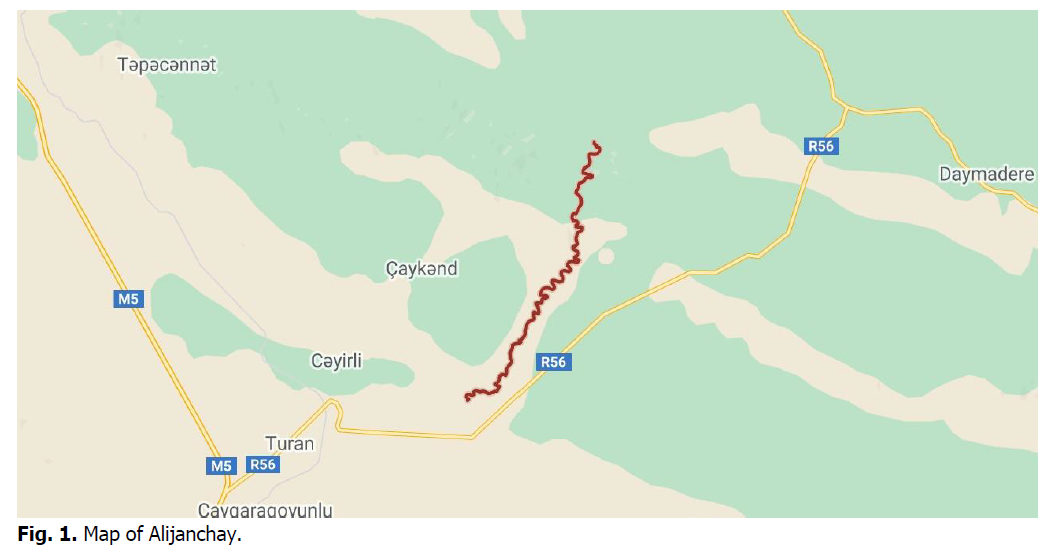
Figure 1: Map of Alijanchay.
Historically, four hydro-biological observation points functioned over the river. 4 biological observation points have been selected to conduct hydro-biological monitoring over the river:
I. Oghuz region, Khalkhalchay N 41o 53ʹ 74; E 47o 33ʹ 35 44ʹʹ
II. Chaygovushan (river сonfluence) N 40o 57ʹ 13,50ʹʹ; E 47o22,37ʹ 37ʹʹ
III. R 56 (next to the bridge) N 40o51,53ʹ 41ʹʹ; E 47o16ʹ 17.99ʹʹ
IV. The point of junction with the Kura River N 40o41ʹ 6.60ʹʹ; E 47o8,8ʹ 40ʹʹ
Currently, the commission envisions a water reservoir for exploration near Jayirly village of the Sheki region over the Alijanchay River. The main objective for constructing the reservoir is to provide water for the population of the region and supply irrigation water for 10 thousand ha planted areas.
Benthic samples in water basins are carried out based on standard methods adopted in hydrobiology (V.I. Jadin, 1956). Organisms that live on the soil at the bottom of the aquifer (epifauna) and inside it (infauna) and are visible to the naked eye generally form macrobenthic organisms, or simply benthos. In benthos, motile forms or vagile creatures (river crustaceans, crabs, octopuses, starfish) lie on the ground, with noticeable immobile or sedimentary forms (ringworms, mollusks, sea urchins), and live sedentary forms or sessile forms (sponges, bryozoans, polyps) that adhere to any solid substrate.
Net shovels, sliders, trawls, and other instruments are used for studying species composition. Samples are collected from depths in up to 1-2 meters of riparian zones of water basins. Materials from deeper areas are taken through special combs and bottom pickers. The materials collected with these tools are washed in a ladle, and the mass remaining in the ladle is filled into special containers, fixed, and labeled with a 4% formalin solution. Materials collected and labeled from different biotopes, different areas, and depths of the basin are removed from the soil under laboratory conditions. The organisms are carefully removed by scraping and placed in special containers containing 4% formalin solution and tightly closed. After this operation, the benthic organisms in each particular container are divided into groups, and their species composition is investigated.
To study the quantity and biomass of organisms living in macrbenthos, samples are collected from different biotopes and depths. At least two samples should be taken with a bottom picker from each of the predetermined survey points in the water basin. The collected material is poured into a washstand on-site, and then the net is washed in a ladle. Washing should be continued until clear water flows from the net foam. Then, the residue left in the shovel is either selected there and fixed in special containers, as it has been mentioned above, or the residue is emptied into a particular container and fixed for the next stage of work.
During the collection of materials, we referred to the methods provided by Katanskaya for high aquatic vegetation (Katanskaya, 1954).
Results
The species composition of basin biodiversity was studied during the observations. The river starts its origin from the southern slope of the Greater Caucasus, flows through the mountain and plain area, and joins Kura River. One hundred fifty-four species of organisms have been found during the study (Fig. 2). Eighty species of found organisms (52%) belong to river macrozoobenthos, 42 species (27%) to plants, and 32 species (21%) to vertebrates.
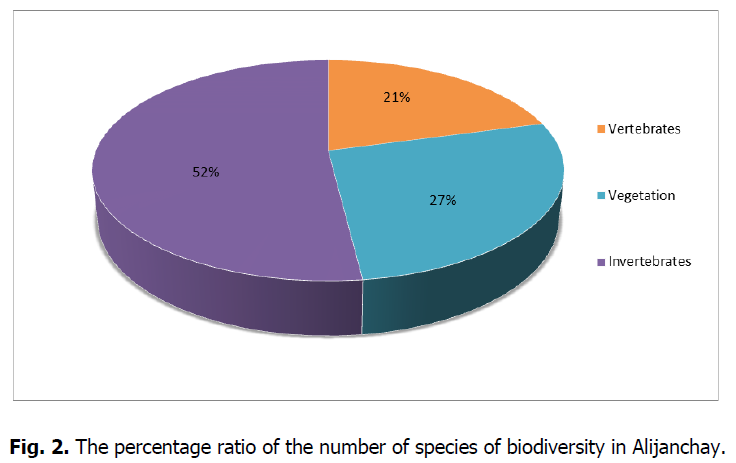
Figure 2: The percentage ratio of the number of species of biodiversity in Alijanchay.
It should be mentioned that Hajiyev conducted a detailed study on vegetation in 1992 (Hajiyev, 1992); the first data on macrozoobenthos of Turyanchay River was provided by Gasimov A.G. (Gasimov, 1972).
Aliyev S.I. studied the macrozoobenthos of rivers of the southern slope of the Greater Caucasus in 2016 (Aliyev,2016).
During the observations in November 2018, 16 species of macrobenthic organisms were recorded in the Alijanchay River. Found organisms include worms (2 species), crustaceans (3 species), Plecoptera (1 species), mollusks (3 species), Odonata larvae (2 species), mayfly larvae (2 species), Hemiptera (1 species), Caddisfly (2 types). As it is known, 43,7% of the recorded species fall to the portion of aquatic insects (Odonata, Ephemeroptera, Hemiptera, Trichoptera). The examples of Oligochaeta represent the registered species - Naiselenquis decapods (1 species of shrimp - Palaemonadspersus), one species of Plecoptera (Perlodesdispar), Amphipoda (Pontogammarus robustoides, Gammarus lacustris), mollusks (Corbicula fluminalis), Hemiptera (Corixaaffinus), Caddisflies (Ecnomustenellus, Limnephilusflavicornis). Other groups are represented with 1-3 species (Fig. 3).
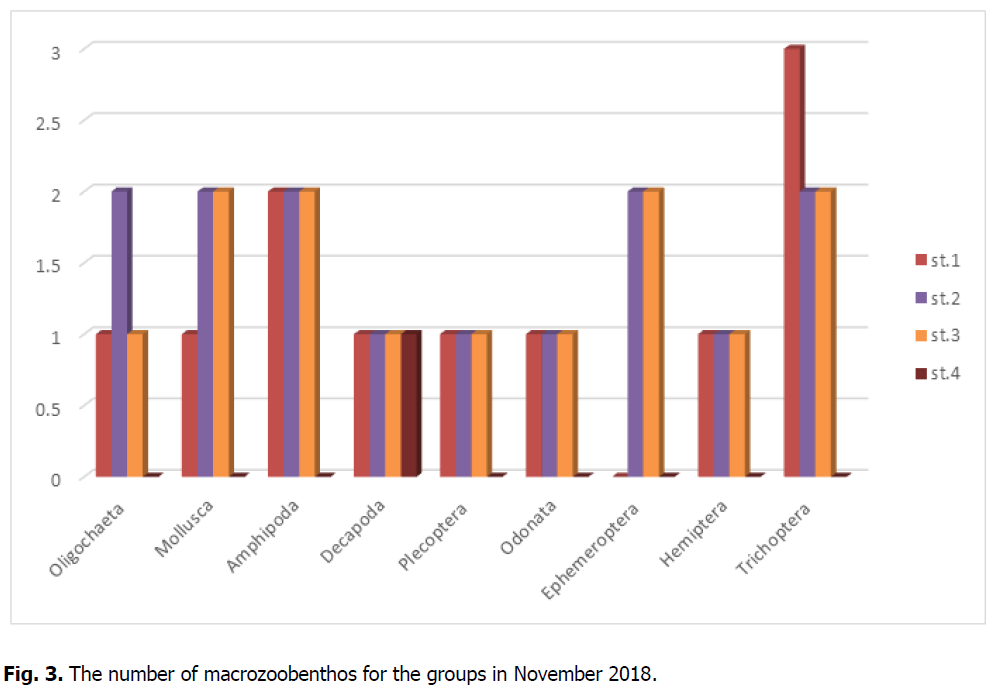
Figure 3: The number of macrozoobenthos for the groups in November 2018.
During the observations conducted in March 2019, 17 species of macrobenthic organisms were recorded in the Alijanchay River. Found organisms include annular worms (1 species), crustaceans (1 species), mollusks (2 species), Odonata larvae (2 species), mayfly larvae (2 species), Chironomidae larvae (6 species), Caddisfly (2 species). As it is known, 63,7% of the recorded species fall to the portion of aquatic insects (Odonata, Ephemeroptera, Hemiptera, Trichoptera, Chironomidae). Other groups are represented with 1-2 species. The examples of Oligochaeta represent the registered species - Naiselenquis, decapods (1 species of shrimp - Palaemonadspersus), floating crustaceans (Gammarus lacustris), mollusks (Corbicula fluminalis, Costatella acuta), Mayflies (Heptageniaperflava, Scphlorunuslinnaenus), odonatan (Lestes sponsa Coenagrionhastulatum), Caddisflies (Ecnomustenellus, Limnephilusflavicornis), Chironomids (Micropscetra praecox, Chironomus plumosus, Pentapedilumexectum, Pelopiavillipennes, Psectocladeuspsilopterus, Procladiuschoereus). The soil of this part of the river mainly consisted of small river stones, sand, and clay (Fig. 4). During the observations conducted in July 2019, 80 species of macrobenthic organisms were recorded in the Alijanchay River, which was included in 12 systematic groups. (Annex 4) Found organisms include annular worms (4 species), leeches (3 species), crustaceans (11 species), mollusks (8 species), Odonata larvae (9 species), Mayfly larvae (11 species), Caddisfly (14 species), Chironomidae larvae (6 species), Simulidaes (4 species), Culicidaes (5 species), Heleidaes (4 species). As it is known, 67% of the recorded species fall to aquatic insects (Odonata, Ephemeroptera, Hemiptera, Trichoptera, Chironomidae, Culicidae, Simuliidae, Heleidae). Other groups are represented with 3-11 species. Forty-eight species of macrobenthic organisms were recorded in Point 1 (Oghuz region, Khal-khal village). The river soil mainly consisted of large and small river stones. The sand was found in certain places. The water temperature was 24°C.
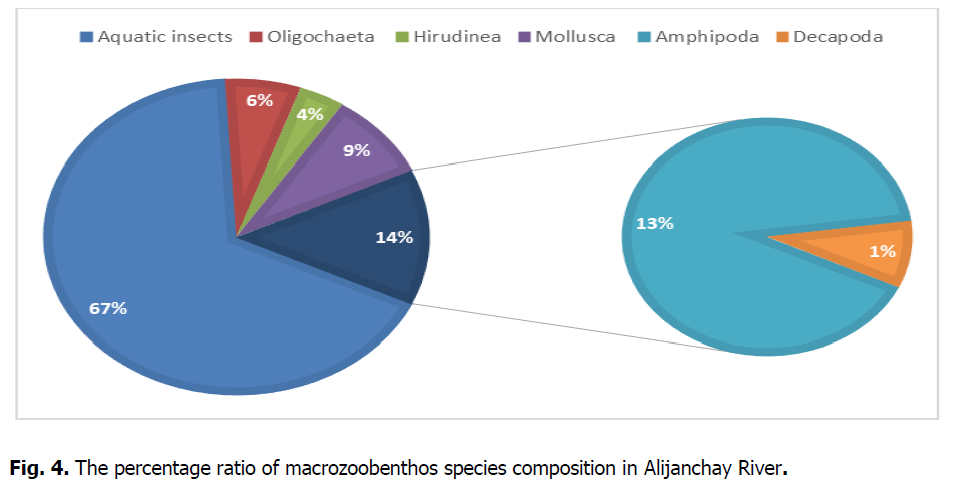
Figure 4: The percentage ratio of macrozoobenthos species composition in Alijanchay River.
During the observations conducted in November 2019, 23 species of macrobenthic organisms were recorded in the Alijanchay River, which was included in six systematic groups. Those organisms include annular worms (3 species), crustaceans (2 species), mollusks (4 species), Odonata larvae (3 species), Mayfly larvae (4 species), Caddisfly (7 species). As it is known, 60,8% of the recorded species fall on the portion of aquatic insects (Odonata, Ephemeroptera, Trichoptera). Other groups are represented with 1-4 species. The examples of Oligochaeta represent the registered species - Naiselenquis, decapods, floating crustaceans (Gammarus lacustris), mollusks (Costatella acuta), and Caddisflies (Ecnomustenellus, Lypereducta). The river soil mainly consisted of large and small river stones. A certain amount of sand was detected in some places. The water temperature was 11,4 °C.
During the observations conducted in January 2020, 12 macrobenthic species were recorded in the Alijanchay River, which were included in 6 systematic groups. Those found organisms include annular worms (2 species), crustaceans (2 species), mollusks (1 species), Odonata larvae (1 species), Mayfly larvae (3 species), Caddisflies (3 species). As it is known, 58,3% of the recorded species fall to the portion of aquatic insects (Odonata, Ephemeroptera, Trichoptera) (Fig. 5).
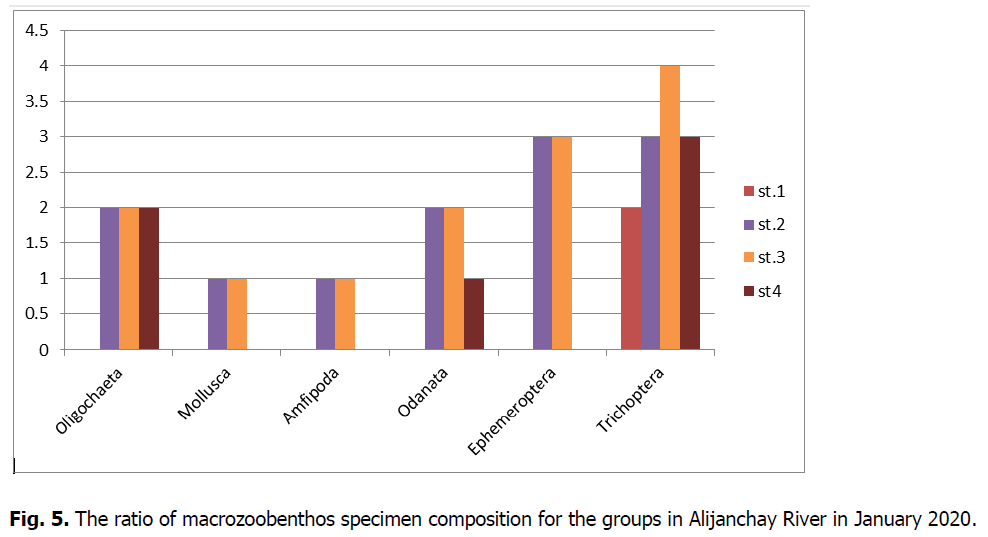
Figure 5: The ratio of macrozoobenthos specimen composition for the groups in Alijanchay River in January 2020.
During the observations conducted in March 2020, 18 species of macrobenthic organisms were recorded in the Alijanchay River, which were included in six systematic groups. Those found organisms include annular worms (2 species), crustaceans (2 species), mollusks (2 species), Odonata larvae (4 species), Mayfly larvae (3 species), Caddisfly (5 species). As it is known, 66,7% of the recorded species fall to the portion of aquatic insects (Odonata, Ephemeroptera, Trichoptera).
During the study, specific water samples were taken from the four stations and sent to the Central Laboratory of the Ministry of Ecology and Natural Resources. Based on the results, the average indicators for physical-chemical elements in water are as follows (Table 1).
| Average | min | max | |
|---|---|---|---|
| Dissolved Oxygen, mg/L | 9 | 8,50 | 11,07 |
| TDS, mg/L | 165 | 114 | 195 |
| Turbidity, NTU | 143 | 1,97 | 990 |
| pH | 8,20 | 7,60 | 8,49 |
| Conductivity, μs/cm | 323 | 228 | 386 |
| Temperature, C | 19,3 | 8 | 28,6 |
| Ammonia (NH4+), mg/L | <0,02 | <0,02 | <0,02 |
| Fluoride (F-), mg/L | 0,13 | 0,09 | 0,15 |
| Chloride (Cl-), mg/L | 4,29 | <3 | 7,1 |
| Nitrite (NO2- ), mg/L | <0,03 | <0,03 | <0,03 |
| Bromide (Br- ), mg/L | <0,05 | <0,05 | <0,05 |
| Nitrate (NO3- ), mg/L | 2 | 0,9 | 3,1 |
| Sulphate (SO42-), mg/L | 51,25 | 30 | 72,5 |
| Phosphate (PO43-), mg/L | 0,44 | <0,04 | <0,5 |
| COD, mg/L | 20 | <5 | 48,3 |
| BOD5, mg/L | 4 | 2 | 19,8 |
| TSS, mg/L | 99 | <2 | 710 |
Table 1. Physical-chemical parameters of water in Alijanchay River during November 2018-March 2020 period.
With the help of the experts involved in UNDP-GEF Kura 2 Project, the initial assessment was conducted to determine the status of the benthic community. The obtained chemical analysis results enable us to summarize that there are normal conditions in the river for the development of organisms (Tables 1 and 2, Fig. 6).
| Benthic Community state assessment – Turyanchay River | |
|---|---|
| November 2018 | Moderate |
| March 2019 | Good |
| May 2019 | Moderate |
| July 2019 | Good |
| August 2019 | Good |
| November 2020 | Moderate |
| January 2020 | Poor |
| March 2020 | Good |
Table 2. The status of the benthic community in the Aliyanchay River.
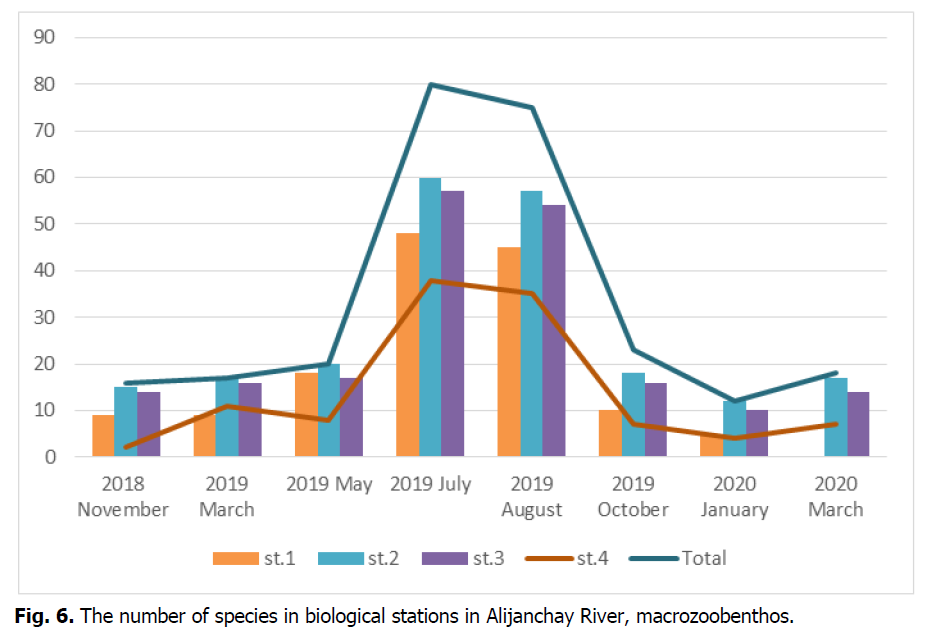
Figure 6: The number of species in biological stations in Alijanchay River, macrozoobenthos.
While summarizing the conducted monitoring results, species varied between 12-80 in Alijanchay (Table 3).
| Biological stations | 2018 November | 2019 March | 2019 May | 2019 July | 2019 August | 2019 November | 2020 January | 2020 March |
|---|---|---|---|---|---|---|---|---|
| st.1 | 9 | 9 | 18 | 48 | 45 | 10 | 5 | 0 |
| st.2 | 15 | 17 | 20 | 60 | 57 | 18 | 12 | 17 |
| st.3 | 14 | 16 | 17 | 57 | 54 | 16 | 10 | 14 |
| st.4 | 2 | 11 | 8 | 38 | 35 | 7 | 4 | 7 |
| Cəmi | 16 | 17 | 20 | 80 | 75 | 23 | 12 | 18 |
Table 3. The number of species in Alijanchaymacrozoobenthos.
It depends primarily on the seasons. It is known that the development and reproduction of hydrobionts occur during the spring and summer seasons. The development dynamics become lower in the autumn and winter seasons. This is because many insects complete the larval stage and fly away (Fig. 7).
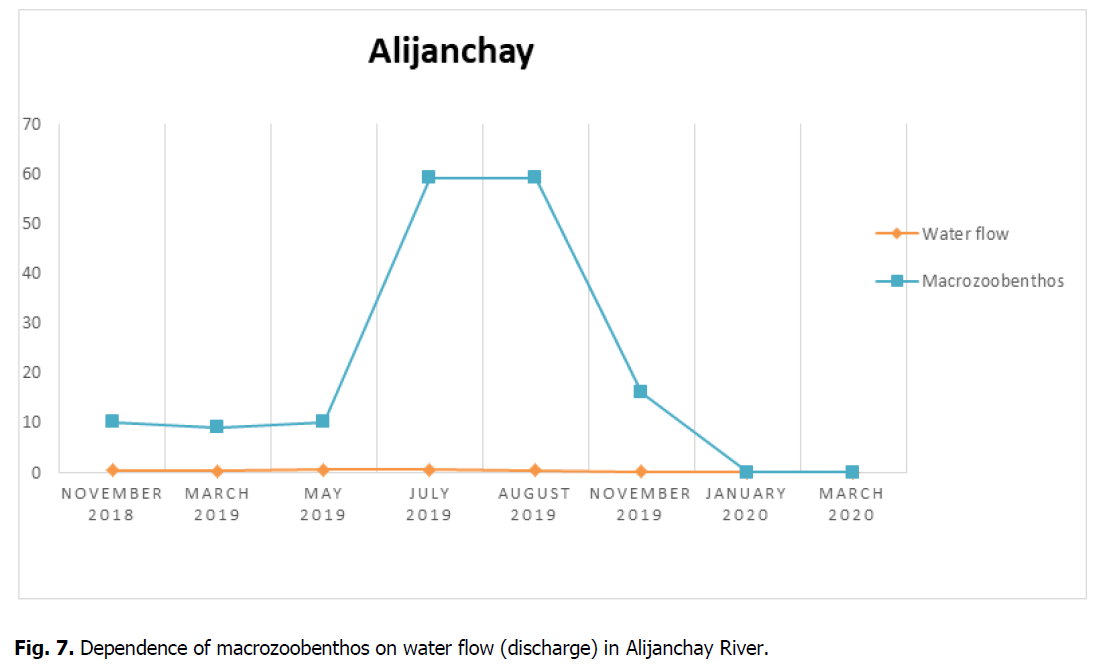
Figure 7: Dependence of macrozoobenthos on water flow (discharge) in Alijanchay River.
The detailed table on species composition of macrobenthos, number of individuals, and saprobity of Alijanchay River are provided below (Table 4).
| Name of species | Saprobity | St.1. Oghuz district, Khal-khal village | St. 2. Gadi (river confluence) | St.3. R.56 next to the bridge | St.4. The point of adjournment to Kura River | |
|---|---|---|---|---|---|---|
| Tip.Annelida Sin. Oligochaeta |
||||||
| 1 | Nais elenquis Müller, 1773 | β | 2 | 6 | 3 | 0 |
| 2 | Auloforus furcatus Mueller | β | 3 | 5 | 6 | 0 |
| 3 | Nais communis Piqueti | β | 1 | 2 | 2 | 1 |
| 4 | N. pseudobtusa Piqueti | β | 3 | 2 | 4 | 1 |
| 5 | N. elinquis Müller | β | 7 | 8 | 10 | 5 |
| Hirudinea | ||||||
| 6 | Haementeria costata (Müller) | β | 2 | 4 | 3 | 2 |
| 7 | Hemiclepsis marginata Müller | β | 0 | 2 | 4 | 6 |
| 8 | Hirudo medicinalis Müller | β | 1 | 1 | 1 | 1 |
| Amphipoda | ||||||
| 9 | Dikerogammarus haemobaphes Eichw. | «0» | 0 | 5 | 7 | 3 |
| 10 | Gammarus lacustris Sars | «0» | 8 | 10 | 12 | 0 |
| 11 | G. karalensis Der. | «0» | 3 | 5 | 8 | 0 |
| 12 | G. balcanicus alarodines Der. | «0» | 4 | 6 | 8 | 6 |
| 13 | G.b.talyschensis Der. | «0» | 0 | 3 | 5 | 6 |
| 14 | G. matienus Der. | «0» | 0 | 4 | 7 | 2 |
| 15 | G. aralensis seyosus Schaferna, 1914 | «0» | 0 | 5 | 3 | 2 |
| 16 | Pontogammarus robustoides Grimm | «0» | 7 | 8 | 11 | 4 |
| 17 | P. sarsi Sov | «0» | 1 | 1 | 1 | 1 |
| 18 | P. maeoticus (Sov) | «0» | 1 | 1 | 1 | 1 |
| Order: Decapoda | ||||||
| 19 | Palaemon adspersus Rathke, 1758 | «0» | 0 | 3 | 4 | 1 |
| Tip. Mollusca | ||||||
| 20 | Costatella acuta Draparnaud, 1805 | «0» | 0 | 3 | 4 | 5 |
| 21 | Corbicula fluminalis Muller, 1774 | «0» | 0 | 2 | 3 | 0 |
| 22 | Lymnaea stagnalis (L.) | «0» | 4 | 5 | 6 | 4 |
| 2 | L. auriculiaria L. | «0» | 10 | 15 | 13 | 8 |
| 24 | L. rectilabrum Ann et Prasch. | «0» | 2 | 4 | 6 | 0 |
| 25 | L.ovata Drap. | «0» | 3 | 5 | 7 | 0 |
| 26 | L. truncatula Müller | «0» | 1 | 5 | 8 | 4 |
| 27 | L. palustris syriaca Germ | «0» | 2 | 6 | 10 | 4 |
| Order: Odonata | ||||||
| 28 | Epallage fatime Charp. | β | 0 | 7 | 9 | 11 |
| 29 | Agrion virgo L. | «0» | 4 | 8 | 10 | 3 |
| 30 |
|
β | 7 | 11 | 14 | 0 |
| 31 | L. virens Charp. | β | 3 | 6 | 5 | 2 |
| 32 | L. sponsa Hans | β | 1 | 3 | 6 | 2 |
| 33 | L. nympha Selys | β | 0 | 4 | 3 | 1 |
| 34 | Sympucna fusca V.d.L. | β | 1 | 1 | 1 | 1 |
| 35 | Platycnemis pennipes Pall. | β | 1 | 1 | 1 | 1 |
| 36 | İschnura elegans V.d.L., 1823 | β | 2 | 2 | 2 | 2 |
| Order: Ephemeroptera | ||||||
| 37 | Palingenia longiscauda Ol. | «0» | 7 | 10 | 13 | 6 |
| 38 | P. fuliginosa Boeb. | «0» | 4 | 10 | 5 | 3 |
| 39 | Ephemera vulgata L. | «0» | 2 | 8 | 4 | 4 |
| 40 | Potamanthus luteus L. | «0» | 3 | 6 | 5 | 2 |
| 41 | Oligoneuriella rhenana İmh. | «0» | 4 | 0 | 0 | 0 |
| 42 | Heptagenia perflava Brod. | «0» | 0 | 0 | 2 | 3 |
| 43 | H. sulfurea Müller | «0» | 6 | 8 | 15 | 10 |
| 44 | Ecdyonuhus arnatipennis Tsher. | «0» | 12 | 14 | 17 | 5 |
| 45 | Ameletus inopinatus Eaton | «0» | 3 | 7 | 9 | 5 |
| 46 | Scphlonurus linnaeanusEtn. | «0» | 4 | 2 | 4 | 4 |
| 47 | Cloeon dipterum (L.) | «0» | 3 | 1 | 6 | 2 |
| Order: Trichoptera | ||||||
| 48 | Lype reducta Hag. | x | 5 | 4 | 3 | 2 |
| 49 | Psychomyia shilkovnikovi Mart. | x | 5 | 7 | 8 | 2 |
| 50 | Ecnomus tenellus Ramb. | x | 6 | 10 | 15 | 12 |
| 51 | Polycentropus sp. | x | 8 | 12 | 13 | 9 |
| 52 | Hydropsyche ornatula McL. | x | 15 | 18 | 9 | 4 |
| 53 | H. instabilis Curtis | x | 3 | 6 | 4 | 0 |
| 54 | H pellucidula Curtis | x | 0 | 7 | 9 | 2 |
| 55 | H. acuta Mart | x | 0 | 3 | 5 | 4 |
| 56 | Cheumotopsyche lepida Pict. | x | 0 | 4 | 6 | 7 |
| 57 | Ch. gracilis (Banks, 1899) | «0» | 0 | 5 | 9 | 10 |
| 58 | Cyrnus flavidus Medachlan | «0» | 0 | 7 | 8 | 9 |
| 59 | Neures lepsis bimaculata L., 1758 | «0» | 2 | 6 | 3 | 1 |
| 60 | Plectrocnemia conspersa (Curtes, 1830) | «0» | 10 | 12 | 14 | 8 |
| 61 | Psychomyia pusilla Fabricius, 1781 | «0» | 2 | 4 | 3 | 1 |
| Family: Simulidae | ||||||
| 62 | Prosimulium petrosum Rubz | «0» | 35 | 70 | 88 | 0 |
| 63 | P. gigas Rubz. | «0» | 0 | 20 | 15 | 28 |
| 64 | P. rachiliense Djaf. | «0» | 0 | 32 | 40 | 14 |
| 65 | Cnephia nigra (Rubz) | «0» | 0 | 0 | 0 | 20 |
| Family: Culicidae | ||||||
| 66 | Anopheles hyrcanicus Pall | «0» | 15 | 10 | 8 | 6 |
| 67 |
|
«0» | 9 | 0 | 2 | 2 |
| 68 |
|
«0» | 5 | 7 | 3 | 2 |
| 69 | Aides caspicus caspicus (Pallas) | «0» | 6 | 10 | 15 | 4 |
| 70 |
|
«0» | 3 | 8 | 7 | 2 |
| Family: Chironomidae | ||||||
| 71 | Micropscetra praecox Meegen | α | 2 | 6 | 8 | 4 |
| 72 | Chironomus plumosus Linnaeus | α | 3 | 5 | 4 | 2 |
| 73 | Pentapedilum exectum Kieffer | α | 3 | 6 | 5 | 2 |
| 74 | Pelopia villipennes Kieffer | α | 0 | 2 | 4 | 2 |
| 75 | Psectocladeus psilopterus Kieffer | α | 0 | 3 | 4 | 0 |
| 76 | Procladius choereus Kieffer | α | 6 | 2 | 2 | 2 |
| Family: Heleidae (Ceratopogonidae) | ||||||
| 77 | Culicoides nubeculosum Mg. | β | 4 | 5 | 3 | 2 |
| 78 |
|
β | 2 | 7 | 9 | 2 |
| 79 |
|
β | 8 | 10 | 11 | 5 |
| 80 | C. musayevi Dzah. | β | 4 | 3 | 2 | 2 |
Table 4. Species composition of macrobenthos, number of individums and saprobity of Alijanchay River.
Conclusion
Biological indicators are satisfying. The water's oxygen regime was 8,02-12,69 mg O2/l, pH was 7,60-8,49, and the temperature varied between 6-28°C in Alijanchay River. Hydrobionts develop well under such values; it is particularly favorable for oxyphilic organisms. As it is known, physical-chemical parameters of water change depending on the season; the temperature gets higher as the winter is replaced by summer, oxygen is getting increased, and the organisms start to develop and reproduce. However, in spring and summer, the amount of oxygen decreases due to photosynthesis in aquatic plants. This process also has its specific impact on the development of oxyphilic organisms. Based on the conducted studies and experiments, it was concluded that the biological regime of Alijanchay is regular; there are favorable conditions for the development of organisms here. The river is exposed to less pollution; it is possible to use river water for the drinking water supply of the population. The establishment of fish farming, especially salmon fishery along the river's riparian zones, is feasible.
References
Aliyev, S.I. (2016). To the study of macrozoobenthos of the rivers, situated in the southern slopes of Greater Caucasus. Bulletin of Zaporizhzhia National University. Biological Sciences, pp:28-34.
Gasimov, A.G. (1972). Freshwater fauna of Caucasus. Baku, Nauka, p:285.
Hajiyev, V.J. (1992). Vegetation map of Azerbaijan. Baku, p:226.
Jadin, V.I. (1956). Methods of studying the bottom fauna of water bodies and the ecology of aquatic invertebrates. From the book: Life of fresh waters of the USSR, 4:226-282.
Katanskaya, V.M. (1956). Methodology for the study of higher aquatic vegetation. Life of Freshwater of the USSR. Moscow-Leningrad, Ed. USSR Academy of Sciences, 4:160-183.
Mammadov, G.S., Khalilov, M.Y. (2002). Azerbaijan forests. Baku, Nauka, p:469.
Mammadov M.A. (2012). Hydrography of Azerbaijan. Baku, p:126-130.
Author Info
S. Aliyev1, V.F. Mammadova2* and L.R. Abdullayeva22Ganja State University, Azerbaijan, Ganja Heydar Aliyev avenue 429AZ 2001, Azerbaijan
Citation: Aliyev, S., Mammadova, V.F., Abdullayeva, L.R. (2021). Macrozoobenthos of Alijanchay river�?�¢??the primary indicator of biodiversity within the Greater Caucasus in the territory of Azerbaijan. Ukrainian Journal of Ecology, 11 (6), 54-62.
Received: 20-Jul-2021 Accepted: 31-Jul-2021 Published: 23-Aug-2021
Copyright: This is an open access article distributed under the terms of the Creative Commons Attribution License, which permits unrestricted use, distribution, and reproduction in any medium, provided the original work is properly cited.
